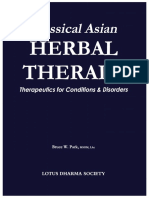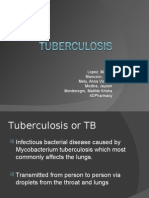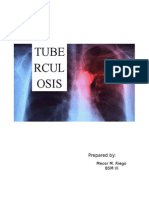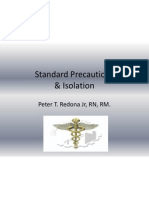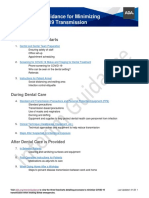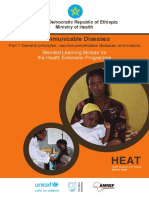Assignment No 1 D
Assignment No 1 D
Uploaded by
danishbiggest124Copyright:
Available Formats
Assignment No 1 D
Assignment No 1 D
Uploaded by
danishbiggest124Original Title
Copyright
Available Formats
Share this document
Did you find this document useful?
Is this content inappropriate?
Copyright:
Available Formats
Assignment No 1 D
Assignment No 1 D
Uploaded by
danishbiggest124Copyright:
Available Formats
Assignment no.
Submitted to:
Dr. Muhammad Zubair-Ul-Hasan Arslan
Submitted by:
Areeba Arshad (LSCI211103081)
Class:
Bs ZOOLOGY 5th
Subject:
ZOOL-4113-Economic Zoology
Topic:
tuberculosis
Khawaja Fareed University of Engineering and Information
Technology
What is the definition of tuberculosis in biology?
Tuberculosis (TB) is a contagious disease caused by infection with Mycobacterium tuberculosis
(Mtb) bacteria. It is spread through the air when a person with TB disease of the lungs or throat
coughs, speaks or sings, and people nearby breathe in these bacteria and become infected
What are the economic impacts of tuberculosis?
The largest indirect cost of TB for a patient is income lost by being too sick to work. Studies
suggest that on average three to four months of work time are lost, resulting in average lost
potential earnings of 20% to 30% of annual household income
Why is tuberculosis in animals economically important?
Bovine tuberculosis is among the primary zoonotic disease caused by Mycobacterium bovis
which has significant impact on the health of livestock and human. It has been significantly a
cause for great economic loss in animal production.
Mycobacterium tuberculosis
Tuberculosis (TB) is caused by a bacterium called Mycobacterium tuberculosis. The bacteria
usually attack the lungs, but TB bacteria can attack any part of the body such as the kidney,
spine, and brain. Not everyone infected with TB bacteria becomes sick
Symptoms
Common symptoms of TB:
prolonged cough (sometimes with blood)
chest pain
weakness
fatigue
weight loss
fever
night sweats
The symptoms people get depend on where in the body TB becomes active. While TB usually
affects the lungs, it also affects the kidneys, brain, spine and skin
What are the symptoms of TB in the lungs?
The general symptoms of TB disease include feelings of sickness or weakness, weight loss, fever,
and night sweats. The symptoms of TB disease of the lungs also include coughing, chest pain,
and the coughing up of blood
Medical treatments
The most common antibiotics used are:
isoniazid
rifampin
pyrazinamide
ethambutol
streptomycin
To be effective, these medications need to be taken daily for 4-6 months. It is dangerous to stop
the medications early or without medical advice. This can allow TB that is still alive to become
resistant to the drugs.
Tuberculosis that doesn’t respond to standard drugs is called drug-resistant TB and requires
more toxic treatment with different medicines
Tuberculosis disease is treated with antibiotics. Treatment is recommended for both TB
infection and disease
What are 4 ways to prevent tuberculosis?
Tips to prevent TB infection
Avoid close contact with people who have active TB disease.
Wash your hands often and cover your mouth when coughing or sneezing.
Eat a nutritious diet and exercise regularly to keep your immune system strong.
Follow these steps to help prevent tuberculosis infection and spread:
Seek medical attention if you have symptoms like prolonged cough, fever and unexplained
weight loss as early treatment for TB can help stop the spread of disease and improve your
chances of recovery
Get tested for TB infection if you are at increased risk, such as if you have HIV or are in contact
with people who have TB in your household or your workplace
If prescribed treatment to prevent TB, complete the full course
If you have TB, practice good hygiene when coughing, including avoiding contact with other
people and wearing a mask, covering your mouth and nose when coughing or sneezing, and
disposing of sputum and used tissues properly
References:
Source: World Health Organization
https://www.webmd.com
You might also like
- 5731Document2 pages5731api-3377137110% (1)
- Classical Asian Herbal TherapyDocument116 pagesClassical Asian Herbal Therapylinecur100% (1)
- TUBERCULOSISDocument7 pagesTUBERCULOSISWilmer PorrasNo ratings yet
- TUBERCULOSISDocument6 pagesTUBERCULOSISByzid ByzidNo ratings yet
- TUBERCULOSISDocument4 pagesTUBERCULOSISamirNo ratings yet
- FB3 - 13-Sudeep Koirala-TuberculosisDocument29 pagesFB3 - 13-Sudeep Koirala-Tuberculosisvaskar_karkiNo ratings yet
- TuberculosisDocument8 pagesTuberculosisArathi KarshNo ratings yet
- Dengue FeverDocument4 pagesDengue FeverDez TabiosNo ratings yet
- Blok 16 AadsDocument6 pagesBlok 16 AadsAlviss RmidNo ratings yet
- 1 - TBDocument36 pages1 - TBAkshayaa GanesanNo ratings yet
- Paper Analisis HL BlumDocument10 pagesPaper Analisis HL BlumRegina MarshaNo ratings yet
- What Is TuberculosisDocument6 pagesWhat Is Tuberculosissachin002kypNo ratings yet
- TUBERCULOSISDocument5 pagesTUBERCULOSISindonesiaserverid0003No ratings yet
- Cours tuberculosediabetEBOAHIVDocument18 pagesCours tuberculosediabetEBOAHIVhamedpourlesmeufsNo ratings yet
- Chronic Inflammation of The Thin Tissue Lining Each Air Sac Causes Scarring and Makes The Sacs Less FlexibleDocument8 pagesChronic Inflammation of The Thin Tissue Lining Each Air Sac Causes Scarring and Makes The Sacs Less FlexibleRosalina MarilaoNo ratings yet
- Power Point 11Document15 pagesPower Point 11zekarias wondafrashNo ratings yet
- Tory O: NameDocument17 pagesTory O: Namejana champakNo ratings yet
- Sneezing: TransmissionDocument13 pagesSneezing: TransmissionMuzammal MollahNo ratings yet
- Disseminated Tuberculosis: Lymph System Tuberculosis - PulmonaryDocument5 pagesDisseminated Tuberculosis: Lymph System Tuberculosis - PulmonaryJeanette C. LimNo ratings yet
- Tuberculosis OrginalDocument11 pagesTuberculosis Orginalthanuja mathew100% (1)
- Tuberculosis: Medical DictionaryDocument5 pagesTuberculosis: Medical DictionarydennisgdagoocNo ratings yet
- TUBERCULOSISDocument4 pagesTUBERCULOSISKim FortichNo ratings yet
- What Is TBDocument2 pagesWhat Is TBAlyssa Mae EscalonaNo ratings yet
- Urinary Tract InfectionDocument20 pagesUrinary Tract InfectionFaraz SiddiquiNo ratings yet
- Mantoux test-TSTDocument13 pagesMantoux test-TSTNektarios TsakalosNo ratings yet
- Article PPT Slogan ReportDocument43 pagesArticle PPT Slogan Reportsourav1980sffNo ratings yet
- جمهوريه العراقDocument6 pagesجمهوريه العراقkhalifa90980No ratings yet
- 1.8 Million: What Is Tuberculosis?Document9 pages1.8 Million: What Is Tuberculosis?rahayusri yayuNo ratings yet
- Symptoms: by Mayo Clinic StaffDocument32 pagesSymptoms: by Mayo Clinic StaffLourghem Libut FerrerNo ratings yet
- The Silent KillerDocument18 pagesThe Silent Killersourav1980sffNo ratings yet
- DefinitionDocument3 pagesDefinitionrahayusri yayuNo ratings yet
- InggrisDocument10 pagesInggrisSiti MaesarohNo ratings yet
- By Hemant Sharma Tuberculosis: Latent TB. in This Condition, You Have A TB Infection, But The Bacteria RemainDocument8 pagesBy Hemant Sharma Tuberculosis: Latent TB. in This Condition, You Have A TB Infection, But The Bacteria RemainHemant SharmaNo ratings yet
- Tuberculosis TBDocument5 pagesTuberculosis TBHusna AmaliaNo ratings yet
- Pulmonary Tuberculosis (TB) : CausesDocument4 pagesPulmonary Tuberculosis (TB) : CausesNikki TinaNo ratings yet
- What Causes Tuberculosis?: Who Is at Risk?Document6 pagesWhat Causes Tuberculosis?: Who Is at Risk?Puskesmas GondangNo ratings yet
- TuberculosisDocument4 pagesTuberculosisMjel Kezhia BarrietaNo ratings yet
- By Mayo Clinic Staff: When To See A DoctorDocument5 pagesBy Mayo Clinic Staff: When To See A DoctorKimberly SolisNo ratings yet
- Unit 06 Human and Microbial Interaction MicrobiologyDocument19 pagesUnit 06 Human and Microbial Interaction Microbiologymq1882341No ratings yet
- Lopez, Marian Manuson, Ludy Melu, Anna Victoria Modina, Jayson Montenegro, Matilde Krisha 4dpharmacyDocument19 pagesLopez, Marian Manuson, Ludy Melu, Anna Victoria Modina, Jayson Montenegro, Matilde Krisha 4dpharmacyRyan100% (1)
- Group Case Study - Pulmonary TBDocument8 pagesGroup Case Study - Pulmonary TBCj NiñalNo ratings yet
- BAHASA - INGGRIS ArtikelDocument4 pagesBAHASA - INGGRIS Artikelindah abdullahNo ratings yet
- Foundation in Science: Biology IiiDocument63 pagesFoundation in Science: Biology IiiLeong Sze XieNo ratings yet
- Universidad Nacional de TrujilloDocument13 pagesUniversidad Nacional de TrujilloWendy Santos MonteroNo ratings yet
- TuberculosisDocument10 pagesTuberculosisagnescheruseryNo ratings yet
- Group Tuberculosis Written ReportDocument7 pagesGroup Tuberculosis Written ReportEricka ParaisoNo ratings yet
- Tuberulosis ProjectDocument29 pagesTuberulosis Projectcalculator.advaithNo ratings yet
- SPURTY COLLEGE OF NURSING TUBERCULOSISDocument7 pagesSPURTY COLLEGE OF NURSING TUBERCULOSISumarfirdous222No ratings yet
- TuberculosisDocument23 pagesTuberculosisKeertana RajagopalNo ratings yet
- Tuberculosis: Latent TB. in This Condition, You Have A TB Infection, But The Bacteria Remain inDocument5 pagesTuberculosis: Latent TB. in This Condition, You Have A TB Infection, But The Bacteria Remain inVinceNo ratings yet
- Case Study TuberculosisDocument8 pagesCase Study TuberculosisCharisse SantillanNo ratings yet
- Tube Rcul Osis: Prepared byDocument11 pagesTube Rcul Osis: Prepared byBal Ri MekoleuNo ratings yet
- Case Study On TBDocument3 pagesCase Study On TBJamil Lorca75% (8)
- TB - OutlineDocument11 pagesTB - Outlinekent yeeNo ratings yet
- Reading TBC by Ananda ZusantyDocument24 pagesReading TBC by Ananda ZusantykhanzahastoNo ratings yet
- Community and HealthDocument6 pagesCommunity and HealthEllee HadesNo ratings yet
- TuberculosisDocument3 pagesTuberculosiseeyakidoNo ratings yet
- The Re-Emergence of Tuberculosis 2Document4 pagesThe Re-Emergence of Tuberculosis 2Navid Ali AskariNo ratings yet
- Tuberculosis 2022Document17 pagesTuberculosis 2022Mohamed HamzaNo ratings yet
- Pulmonary TuberculosisDocument6 pagesPulmonary TuberculosisZachary CohenNo ratings yet
- TuberculosisDocument4 pagesTuberculosisdreamxtreme16100% (3)
- Psoriasis For DummiesDocument20 pagesPsoriasis For DummiesANTolaniNo ratings yet
- Ulcers: DR Sarah Mutwakil Abbas Diab MBBS, Mrcsed, MhpeDocument33 pagesUlcers: DR Sarah Mutwakil Abbas Diab MBBS, Mrcsed, MhpeSarah M. A. DiabNo ratings yet
- Emerging and Reemerging InfectionsDocument57 pagesEmerging and Reemerging Infectionstummalapalli venkateswara raoNo ratings yet
- PneumothoraxDocument36 pagesPneumothoraxEira Lopez56% (9)
- Total ThyroidectomyDocument3 pagesTotal ThyroidectomyReyniel Pablo ElumbaNo ratings yet
- Standard PrecautionsDocument20 pagesStandard PrecautionspomiakhterNo ratings yet
- InfluenzaDocument1 pageInfluenzakeoneulaNo ratings yet
- Ppi Di Icu RS TiaraDocument39 pagesPpi Di Icu RS TiaraRS TiaraNo ratings yet
- ADA COVID Int Guidance Treat Pts PDFDocument8 pagesADA COVID Int Guidance Treat Pts PDFFavio LunaNo ratings yet
- Antigen Non Struktural 1 (Ns1) Sebagai Marker Suspek Infeksi DengueDocument7 pagesAntigen Non Struktural 1 (Ns1) Sebagai Marker Suspek Infeksi DenguelidawatiNo ratings yet
- Acceptability and Effectiveness of Using Mobile Applications To Promote HIV and Other STI Testing Among Men Who Have Sex With Men in Barcelona, SpainDocument7 pagesAcceptability and Effectiveness of Using Mobile Applications To Promote HIV and Other STI Testing Among Men Who Have Sex With Men in Barcelona, SpainMiguelAlarconGutierrezNo ratings yet
- Intrinsic and Extrinsic Incubation PeriodDocument5 pagesIntrinsic and Extrinsic Incubation PeriodCirimpei PaulNo ratings yet
- Letter Sent To Schools in Linn County On FridayDocument1 pageLetter Sent To Schools in Linn County On FridayA.W. CarrosNo ratings yet
- Clinical Aspects of NeoplasiaDocument23 pagesClinical Aspects of NeoplasiaJahanzaib BashirNo ratings yet
- (My) Prevention and Control of Infectious Diseases Act 1988 Act 342Document22 pages(My) Prevention and Control of Infectious Diseases Act 1988 Act 342Chris ChuahNo ratings yet
- Soal Listening Us 2020-2021 Paket CDocument7 pagesSoal Listening Us 2020-2021 Paket CSiska Yani Desi KarlinaNo ratings yet
- A Moroccan Colorectal Cancer DatabaseDocument6 pagesA Moroccan Colorectal Cancer DatabaseDavidNo ratings yet
- Frequently Asked Questions About SCDC and Coronavirus (SCDC)Document3 pagesFrequently Asked Questions About SCDC and Coronavirus (SCDC)ABC15 NewsNo ratings yet
- Research. ReviewedDocument14 pagesResearch. Reviewednjukierick03No ratings yet
- 2020-EO Amendment EO 05-005 Reorganization CIC EOCDocument4 pages2020-EO Amendment EO 05-005 Reorganization CIC EOCDennis CosmodNo ratings yet
- Gambaran Status Kebersihan Gigi Dan Mulut Pada Pengidap HIV/AIDS Di Yayasan Batamang Plus BitungDocument5 pagesGambaran Status Kebersihan Gigi Dan Mulut Pada Pengidap HIV/AIDS Di Yayasan Batamang Plus BitungWidya Sri IswariNo ratings yet
- Coomunicable DiseaseDocument182 pagesCoomunicable DiseaseAbdi DanielNo ratings yet
- Fundoscopy: Learning OutcomesDocument6 pagesFundoscopy: Learning OutcomesSaraNo ratings yet
- Leprosy Guideline - 2Document6 pagesLeprosy Guideline - 2Central Leprosy Division DGHSNo ratings yet
- Laporan Kasus TB MDRDocument12 pagesLaporan Kasus TB MDRRiyantono PutraNo ratings yet
- Arthritis Thesis StatementDocument5 pagesArthritis Thesis Statementafjwfzekzdzrtp100% (1)
- Critically Appraised Topic Prophylactic Oral Antibiotics For Low-Risk Dog Bite WoundsDocument2 pagesCritically Appraised Topic Prophylactic Oral Antibiotics For Low-Risk Dog Bite Woundsyulei daiNo ratings yet
- Copy of Rekap Diet Bulan Maret 2020Document88 pagesCopy of Rekap Diet Bulan Maret 2020Mursyida RahmahNo ratings yet

